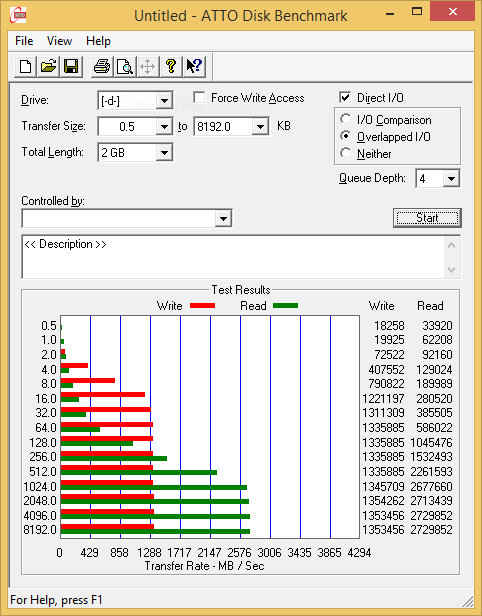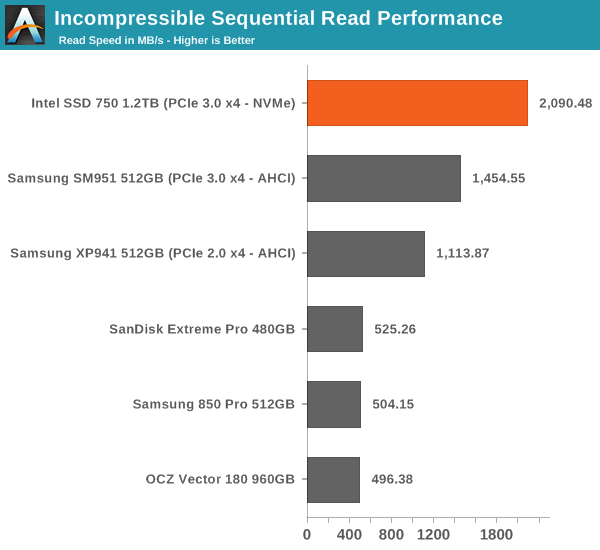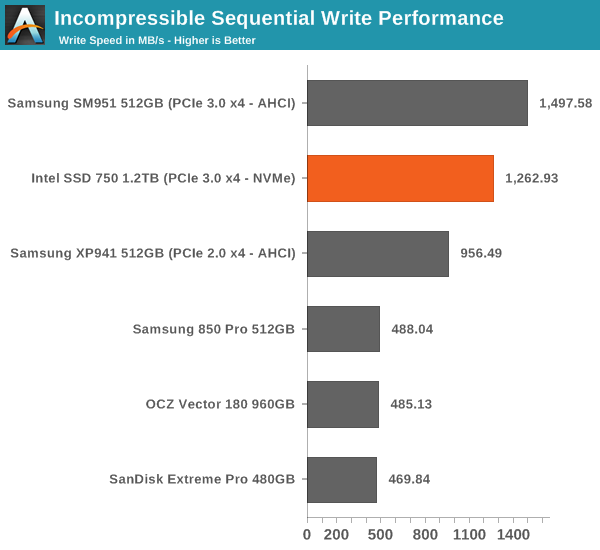Intel SSD 750 PCIe SSD Review: NVMe for the Client
by Kristian Vättö on April 2, 2015 12:00 PM ESTATTO - Transfer Size vs Performance
I'm keeping our ATTO test around because it's a tool that can easily be run by anyone and it provides a quick look into performance scaling across multiple transfer sizes. I'm providing the results in a slightly different format because the line graphs didn't work well with multiple drives and creating the graphs was rather painful since the results had to be manually inserted cell be cell as ATTO doesn't provide a 'save as CSV' functionality.
 |
|||||||||
AS-SSD Incompressible Sequential Performance
I'm also keeping AS-SSD around as it's freeware like ATTO and can be used by our readers to confirm that their drives operate properly. AS-SSD uses incompressible data for all of its transfers, so it's also a valuable tool when testing SandForce based drives that perform worse with incompressible data.


TRIM Validation
The move from Windows 7 to 8.1 introduced some problems with the methodology we have previously used to test TRIM functionality, so I had to come up with a new way to test. I tested a couple of different methods, but ultimately I decided to go with the easiest one that can actually be used by anyone. The software is simply called trimcheck and it was made by a developer that goes by the name CyberShadow in GitHub.
Trimcheck tests TRIM by creating a small, unique file and then deleting it. Next the program will check whether the data is still accessible by reading the raw LBA locations. If the data that is returned by the drive is all zeros, it has received the TRIM command and TRIM is functional.
And as expected TRIM appears to be working.











132 Comments
View All Comments
magreen - Thursday, April 2, 2015 - link
darkgreen, are you talking about a G1 without TRIM or a G2 with TRIM support?darkgreen - Friday, April 3, 2015 - link
I had a G1 without TRIM. The Intel fix was based on some ancient shareware (FreeDOS!) that wouldn't work with many modern motherboards and in some cases left drives bricked. It was well reported at the time (see my comment above for a google search that returns articles), but lots of people wound up with X25-Ms that were useless. If you weren't an enterprise customer the Intel response was "tough luck." No refunds, no replacements, nothing. In all fairness I'm sure Intel would love to be able to support consumers, but they probably aren't set up for it in their storage area because it's just not a big area of their business bottom line.magreen - Sunday, April 5, 2015 - link
Yeah, it seems like the G1 owners got screwed. (I have a G2 and G3 and they've both been great. Sorry they screwed the early adopters.)In Anand's words from 2009 when the G2 was released:
"TRIM isn’t yet supported, but the 34nm drives will get a firmware update when Windows 7 launches enabling TRIM. XP and Vista users will get a performance enhancing utility (read: manual TRIM utility). It seems that 50nm users are SOL with regards to TRIM support. Bad form Intel, very bad form."
http://anandtech.com/show/2806
"Overall the G2 is the better drive but it's support for TRIM that will ultimately ensure that. The G1 will degrade in performance over time, the G2 will only lose performance as you fill it with real data. I wonder what else Intel has decided to add to the new firmware...
I hate to say it but this is another example of Intel only delivering what it needs to in order to succeed. There's nothing that keeps the G1 from also having TRIM other than Intel being unwilling to invest the development time to make it happen. I'd be willing to assume that Intel already has TRIM working on the G1 internally and it simply chose not to validate the firmware for public release (an admittedly long process). But from Intel's perspective, why bother?
Even the G1, in its used state, is faster than the fastest Indilinx drive. In 4KB random writes the G1 is even faster than an SLC Indilinx drive. Intel doesn't need to touch the G1, the only thing faster than it is the G2. Still, I do wish that Intel would be generous to its loyal customers that shelled out $600 for the first X25-M. It just seems like the right thing to do. Sigh."
http://www.anandtech.com/show/2829/11
Redstorm - Thursday, April 2, 2015 - link
Could you elaborate on this (although there appears to be an NVMe version too after all) of the SM951. As looking at the numbers if NVMe even slightly improves the SM951 it would make it a better choice, and the form factor being M.2 makes it much more attractive.Kristian Vättö - Thursday, April 2, 2015 - link
Ganesh received an NVMe version of the SM951 inside a NUC and I've also heard from other sources that it exists. No idea of its retail availability, though, as RamCity hadn't heard about it until I told them.eddieobscurant - Thursday, April 2, 2015 - link
if i'm not wrong the nvme version has p/n MZVPV256HDGL-00000 for the 256gb model while the ahci version has p/n MZHPV256HDGL-00000Redstorm - Friday, April 3, 2015 - link
Thanks looks promising , found this with verbage suposidly from RAMCity that they will ship in May.http://translate.google.co.nz/translate?hl=en&...
Redstorm - Friday, April 3, 2015 - link
So no real proof that they exist then.eddieobscurant - Thursday, April 2, 2015 - link
Kristian, there is a DRAM difference between the two models. The 400gb has 1gb DRAM while the 1.2tb model has 2gb. Do you think it plays a big role in terms of performance between the two models.Also is there a way to reduce the overprovision in these drives? I would prefer 80gb more on the 400gb model over less consistency.
When will you review the kingston hyperX predator, and when will samsung release the sm951 nvme? Q3 or sooner?
KAlmquist - Thursday, April 2, 2015 - link
The 400gb model shouldn't need as much DRAM because it has fewer pages to keep track of. But there's no way to know how the 400gb model will perform until Intel sends out samples for review.